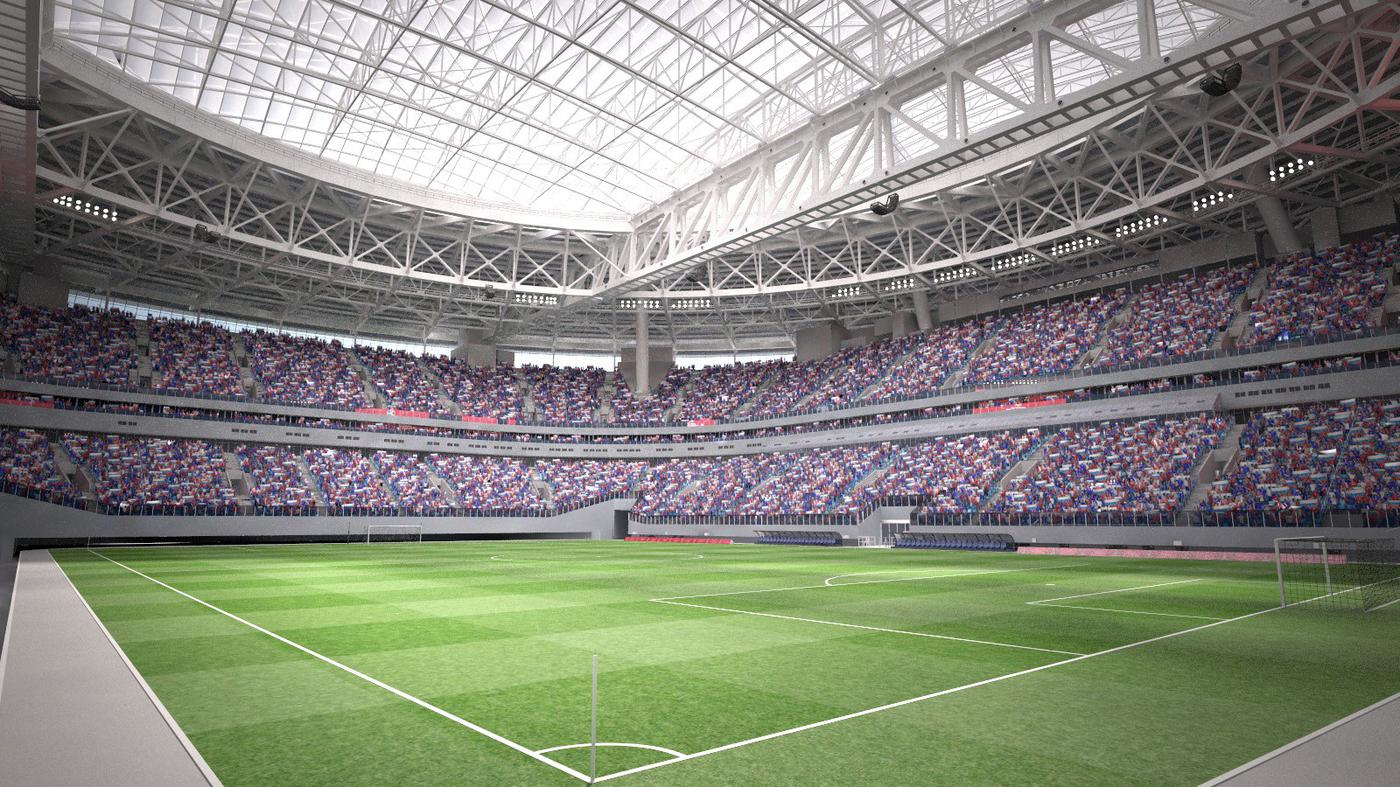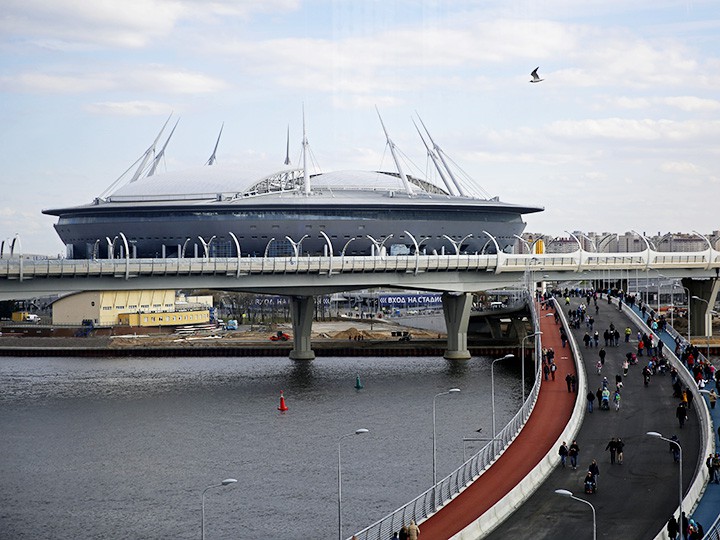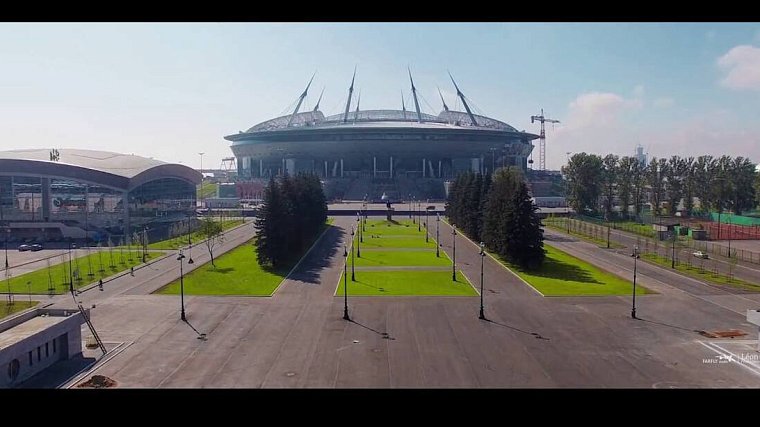Text by RT journalist Alan Moore
Costing more than $1.5 billion, late opening only to be closed once more for “touch ups”, the Zenit Arena in St. Petersburg is probably one of the most beautifully designed messes you’d ever see. I’ve been in 3 stadia used by Zenit since 1991, the Kirov Stadium, Petrovsky Stadium and the Zenit Arena. In 1991 I was told by our newly found friends in St. Petes that the Kirov was once one of the biggest in the World. Located where the Kirov once stood, the Zenit Arena has the potential to be one of the greatest in the World (after Croke Park of course), though it also could be a financially ruinous money pit. And this isn’t just an issue for football, World Cups or Russia.
Sports stadia are not just about returns on investments. Not just photo opps for vainglorious politicians and club chiefs. Not even about ‘enhancing viewing performance’ or ‘symbolism’. The most important feature of a sports venue is how much it contributes to the well being of the surrounding community. By doing that, it will be self-sustaining. Yet this gets completely lost as soon as greed, ambition and corruption takes hold.
Tenderly corrupt
The first time I was part of a bid/project team was in 1994. Our University were bidding to host an International boxing competition. The only corruption was where to hold the main after party, in the student bar or elsewhere. The inducement — a free keg of Budweiser for our next boxing show. The student bar won, we’d offer half the keg as prizes for spectators and the rest would be divided up amongst the fighters.
Fast forward 19 years, a Russian region and multi-project tender team. The 1st step - redevelop a stadium to measurably improve local business, life and recreation. Low cost, high quality and carefully planned, I was proud to be involved, until backroom shenanigans began. Before the key presentation to local stakeholders, the builder and pitch installation contractor agreed to increase their profit shares by installing sub-standard pitches, electrics and concrete. In addition they worked out a deal to subcontract most work to Chinese slave workers and Central Asians.
Sitting outside the office of the Deputy Governor, with locals all around us and they were discussing ripping them off. In improved figures read:
$2.5 mln cost - Net Profit $215,000 ---------> $550,000
Local jobs — Temporary 250 ---------> 13
This was the first of 12 projects over 7 years to 2020. The smallest yet most important. It would give the city a high quality 8,000 seater stadium, Academy base, commercial and social space and 20 apartments. I asked if they were serious, they were. 15 minutes later we were before the decision makers, the builder pitching hard. When asked, in Russian, if I thought their plans added up. I thought of their answer to me — “if it falls down in 10 years time we’ll be well out of it”. I shrugged my shoulders. I contributed 12 words to the meeting. The tender failed, but their way of business did find willing partners, the potato patches at the Otkritie and Zenit Arena’s stand testament to it.
Comment:
Most stadia in Europe, pre-1990’s, were not built for viewing or supporter comfort. When the North Americanisation of sport took full hold, supporters became fans, fans became consumers. Get ‘em in, fleece ‘em, get ‘em out. Yet there are distinct differences between markets. What continues in the USA and Ireland as timeworn, trusted traditions had a different sheen in the UK and Europe, certainly so in Russia. Tailgate parties before College or NFL football matches have to be experienced to be believed. Likewise eating ‘hang sangiches’ (ham sandwiches) from the boot of a car before a GAA match in Ireland has yet to disappear in this increasingly high consumer age. Inside Croke Park or New York Giants MetLife Stadium, the surrounds are modern and comfortable, both blend old tradition with good business to make going to matches a worth it.
Building for a future
When, in 2003, we’d 5 people injured attending matches at the Poljud (home of Hajduk Split), a Croatian Football Union official decried the lack of investment in the ground. The club begged the City of Split (stadium owner) for investment. Monies were released and an upgrade of the home dressing room, player salary debts and reupholstered seats for VIPs followed. In 2004 a teen girl had her ankle crushed when a loose concrete slab tumbled as she walked up steps in the West Stand. The supporters and community didn’t matter, despite the rhetoric. As for who got to do the improvements, would it surprise anyone to know it was the brother of a Board member? The future never came into the heads of those tasked with building for it.
I first visited Lokomotiv Moscow’s stadium in 2006 and found it fan friendly and far better than the dangerous Luzhniki or assorted regional jumbles I’d visited. 10 years on from my first encounter, the stadium was a shambles. With just 5,000 ‘consumers’ at the last match of the 2015-16 season, it wasn’t just the corrupt Smorodskaya regime that looked like coming to an end. Yet 12 months later the stadium now has the Russian Cup on show, a happy team, increasingly engaged supporters and motivated management. Increasingly connected with their community, they continue investing in their infrastructure and future. It’s not perfect, but could serve as a simple blueprint for a World Cup legacy.

Russia’s Golden Own Goal?
The 2018 FIFA World Cup was to herald the beginning of a new era for Russian football and sport. However we learned from the Sochi debacle, the battle between ambition, corruption and greed that saw thousands evicted from their homes and a for profit doping Doctor make his fortune before fleeing justice, it was not going to be easy. A genuine chance to improve Russia’s sports infrastructure looks depressing.
The Zenit Arena will make money, from concerts, sports and good management, eventually. The Otkritie Arena will continue to lose money, okay until Fedun loses interest. Saransk will fall into disuse within 5 years. Volgograd is a sports city, though the unwillingness to clean up shop there means no return to the bright days of a Rotor team in Europe. Ekaterinaburg deserves a club to deliver success and European football.. Kazan, if the Tatar internecine struggles recede, will welcome European football every 2nd year. The vanity project in Sochi will remain a shining white elephant on the Black Sea. Luzhniki is set to become a genuine sports hub, a Russian version of Sports Campus Ireland. It will have great days ahead, especially if the Otkritie closes and Spartak look for a new home. Samara will host Premier football again and has the support to keep the Cosmos Arena alive.
Kaliningrad is built on sand, literally and will prove an expensive failure. Nizhny Novgorod, despite the city’s potential, has neither the leadership nor foresight to have Spurs, Bayer or Sevilla visit. Rostov has shown itself to be a city deserving of support and should they invest their European money wisely, the Rostov Arena will rock. The disasters that befell the stadia post-2014 in Brazil won’t be as devastating in Russia. However 5 of the 12 Russian venues are almost certain to be expensive relics in 5-10 years.
Legacy or Lunacy
The night Russia won the right to host the FIFA World Cup, a rather dubious English reporter told listeners on Irish radio that from now on only totalitarian regimes would bother to host major sports events. I agreed, though that it would be better seen through the prism of ‘“legacy” bequeathed to the nation. Sochi and the World Cup were Vladimir Putin’s to Russia, London’s 2012 Olympics a Blair gift to the UK and so on. He disagreed, saying that Putin was a warmonger. I politely reminded him of Wor Tony’s adventures in Afghanistan and Iraq. One man’s leader is another’s warmonger.
Rather, was it seeking a legacy or just pure lunacy for VVP get the World Cup on Russian soil? The legacy of 12 stadia on paper looks good, if Russian football and sports were healthy. It can be viewed as a lunacy when only 5 will host top flight football in 2017-18.

The legacy of parallel infrastructure projects — improved transport links, city beautification and local hubs mean that the veins for business and societal growth are developing. What happens inside the stadia for a few weeks next Summer is not as important is what as the week in, week out toil of local football, and the #WeareRussia project of the RFU and ARFPU, headed by Smertin and supported by Shirokov, will make Russian football matches better places to be.
